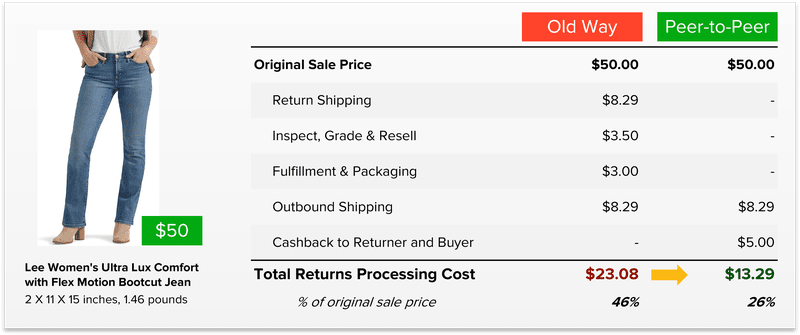Best Practices for an Effective Ecommerce Return Policy (2025)

Last updated on April 16, 2025

In this article
 8 minutes
8 minutes
- Key Takeaways
- Importance of an Ecommerce Return Policy
- Key Elements of a Strong Return Policy
- Common Mistakes to Avoid
- Customer-Centric Return Policies
- Sustainability in Returns Management
- Leveraging Technology for Efficient Returns
- Handling Seasonal Return Spikes
- Examples of Effective Return Policies
- Summary
- Frequently Asked Questions
An ecommerce return policy is vital for building customer trust and driving sales. In this article, you’ll learn why a good return policy matters and discover key elements to make your policy customer-friendly and efficient.
Key Takeaways
- A clear and customer-friendly return policy boosts buyer confidence and can increase sales and repeat purchases.
- Key elements of an effective return policy include clear return timeframes, conditions for return eligibility, and diverse refund options.
- Proactive strategies like accurate product descriptions and sustainability efforts can help reduce return rates and enhance customer loyalty.
Importance of an Ecommerce Return Policy

A clear return policy is more than just a set of rules; it’s a confidence booster for potential buyers. Nearly half of ecommerce shoppers check return policies before finalizing their purchase, showcasing their significant influence on buying decisions. When customers know they can return a product easily if it doesn’t meet their expectations, they’re more likely to hit that “buy now” button.
A solid return policy extends beyond initial purchases by building trust, which is essential for long-term customer relationships. A well-implemented return policy can help increase conversion rates and encourage repeat purchases. Conversely, failing to meet customer expectations with return policies risks losing returning customers, which can be particularly damaging for luxury or specialized products.
Prominently displaying return policies is essential; otherwise, it can lead to a lack of trust among customers. A prominently featured return policy reduces frustration, enhances customer satisfaction, and can even increase sales. In today’s competitive market, a great return policy can generate new profits and significantly boost customer loyalty for online stores.
Ultimately, crafting an ecommerce return policy template goes beyond compliance. It’s about maintaining customer satisfaction and ensuring long-term business success through clear ecommerce returns processes.
Key Elements of a Strong Return Policy

A robust webstore’s return and refund policy is the backbone of a satisfying customer experience. To enhance transparency, it should clearly communicate specific conditions for returns, refund options, the refund policy, and the overall process, ensuring clarity and customer satisfaction.
Next, let’s explore the essential components of an effective return policy.
Clear Timeframes for Returns
Setting a clear timeframe for returns is paramount. Interestingly, two-thirds of consumers expect online stores to accept returns within 30 days. Highlighting these deadlines on the returns page minimizes confusion and enhances customer trust, ultimately boosting sales and operational efficiency.
Conditions for Return Eligibility
Clearly stating the conditions under which items can be returned helps prevent misunderstandings. For example, “Items must be in their original condition and packaging, with tags still attached.”
Additionally, under U.S. federal law, return policies must accept defective merchandise back, ensuring legal compliance and customer satisfaction.
Refund and Exchange Options
Clarifying the difference between a return and a refund is vital. For example, distinguishing between offering store credit instead of full refunds encourages repeat purchases and minimizes financial losses.
Additionally, providing options like in-store returns or a prepaid return shipping label makes the process more convenient for customers.
Common Mistakes to Avoid
Online retailers that stumble into common pitfalls can frustrate customers and harm their reputation. Ecommerce businesses that don’t clearly communicate return timeframes or overcomplicate the return process are two major mistakes. Clearly defining acceptable conditions for returns avoids misunderstandings and ensures customer compliance.
Customer-Centric Return Policies
Customer-centric return policies are designed with the shopper in mind, enhancing overall satisfaction and nurturing loyalty. Such policies can increase repeat purchases and foster long-term revenue growth, ultimately supporting customer retention.
Next, we’ll explore specific elements that make return policies truly customer-friendly.
Free Return Shipping
Free return shipping can significantly influence customer purchasing decisions, with three-quarters of consumers considering it essential. This practice, offering free return shipping, not only increases customer satisfaction but also boosts loyalty and repeat purchase rates.
Easy Return Process
An easy return process is foundational for customer satisfaction. Clear instructions and easy-to-print return labels are highly desired by half of online shoppers. Streamlining the return process reduces frustration and encourages repeat business.
Fast Refund Processing
Speed is of the essence when processing refunds. More than half of customers are willing to spend more if they know their refund will be processed quickly. Quick refunds prevent customers from feeling their funds are tied up, thereby fostering loyalty and encouraging repeat purchases.
Reducing Return Rates Proactively
Reducing return rates involves both handling returns efficiently and preventing them. Proactive strategies can minimize returns and improve customer satisfaction.
Let’s explore some key approaches in the following subsections.
Accurate Product Descriptions
Accurate and detailed product descriptions help align what customers expect with what they actually receive. When customers receive what they expect, they are less likely to return items.
Quality Control Measures
Regular quality testing and consultations with manufacturers can significantly reduce product defects. Quickly identifying quality issues helps mitigate high return rates.
Utilizing Customer Feedback
Data analytics offer valuable insights into return behaviors. Improving product quality based on customer feedback leads to enhanced satisfaction and loyalty.
Sustainability in Returns Management

Eco-friendly practices in returns management are not only good for the planet but also for business. Today, nearly 80% of shoppers consider sustainability in their purchasing decisions.
Green Returns Initiatives
Encouraging customers to keep low-cost items (returnless refunds) minimizes waste and promotes sustainable consumption. This practice enhances sustainability and reduces shipping costs.
Boxless Returns
Boxless returns eliminate traditional packaging requirements, reducing waste and shipping costs. This modern approach consolidates returns into bulk processing workflows and makes it easy for customers to drop off returns while running errands.
Peer-to-Peer Returns
The peer-to-peer returns model reduces shipping expenses and processing time by allowing the returning customer to ship directly to the next customer. This approach is cost-effective and efficient.
Publishing Sustainability Reports
Transparency regarding sustainability metrics fosters trust among eco-conscious customers. Brands should publish sustainability reports that include concrete metrics such as carbon emission reductions or resource savings.
Leveraging Technology for Efficient Returns
Technology plays a pivotal role in streamlining the returns process. Automated returns management helps businesses reduce errors and labor costs through improved efficiency.
Return Management Systems
Return management systems help reduce customer service hours and manage returns efficiently. These systems typically include digital forms or online portals for refund requests and automatic shipping label generation.
Reverse Logistics Solutions
A robust reverse logistics process that adapts to changing circumstances is essential for efficient returns. Third-party logistics providers offer prepaid return labels and tracking information, enhancing the return process for customers.
Analyzing Return Data
Monitor data analytics reports to identify return trends and make informed decisions about adjustments to minimize future returns. Technology helps track returns and automates many aspects of the process.
Handling Seasonal Return Spikes
Seasonal spikes in returns—especially after the holidays—can be overwhelming. Effective strategies are essential for managing increased return volumes and maintaining customer satisfaction.
Extending Return Windows
Extending the return window during holiday seasons accommodates customer needs and improves overall satisfaction. This practice encourages early shoppers and fosters loyalty.
Automating Return Processes
Automating the return process helps manage high volumes efficiently during peak seasons. Return management systems can simplify the process for both customers and businesses, reducing costs and smoothing the workflow.
Preparing for Peak Seasons
Collaborating with third-party logistics providers can increase capacity to handle higher return volumes during busy periods. Scaling operations in advance helps meet customer expectations effectively.
Examples of Effective Return Policies
Leading brands like Target and Costco set benchmarks with their customer-friendly return policies. Target extends its return period for RedCard holders, providing an additional 30 days for returns. Costco’s satisfaction guarantee allows returns at any time for a full refund, making it one of the most accommodating policies in retail.
Summary
To summarize, a well-crafted return policy is essential for customer satisfaction and business success. From clear timeframes and conditions to sustainability and technology integration, every element plays a crucial role. Embracing these best practices helps create a return policy that not only meets but exceeds customer expectations.
Frequently Asked Questions
Why is a clear return policy important for ecommerce businesses?
A clear return policy builds customer confidence and encourages purchases, knowing that items can be returned if they do not meet expectations. This boosts customer retention and satisfaction.
What are the key elements of a strong return policy?
A strong return policy includes clear timeframes for returns, specific conditions for return eligibility, and multiple refund or exchange options. These elements ensure a hassle-free experience for customers.
How can businesses reduce return rates proactively?
Ensuring accurate product descriptions, implementing rigorous quality control measures, and utilizing customer feedback help minimize returns and improve satisfaction.
What role does technology play in managing returns?
Technology plays a crucial role in managing returns by automating processes and using data analytics to track trends, making everything smoother and more efficient. It really helps businesses get a grip on their return logistics!
How do customer-centric return policies benefit businesses?
Customer-centric return policies build loyalty, boost repeat purchases, and drive long-term revenue by ensuring customer satisfaction throughout the return process.

Up to 64% Lower Returns Processing Cost


